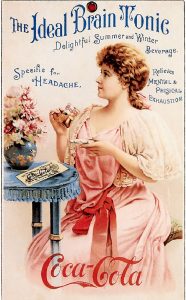
IT was inspired partly by a quest to find an alternative to morphine, but the drink that John Pemberton invented was of little help in his final days. Down on his luck financially and suffering stomach cancer, he sold most of his rights to Coca-Cola in a desperate attempt to revive his fortunes.
But on August 16, 1888, 130 years ago today, Pemberton died before he could see his drink become one of the great American success stories.
Pemberton, a chemist and US Civil War veteran, never got to enjoy the benefits of his creation. Today Coca-Cola is still consumed in vast quantities worldwide, but drinkers who complain about the company tinkering with the recipe may be surprised to learn how much tinkering went on in the early years to turn what was meant to be a medicine into a soft drink.
John Stith Pemberton was born in Knoxville, Georgia, on July 8, 1831, but was raised mostly in Rome (also in Georgia) . He studied at the Reform Medical College of Georgia in Macon, graduating in 1850 to practise pharmacy in botanic Thomsonian Medicine, an alternative system derived largely from natural herbal remedies.
Thomsonians were followers of Samuel Thompson, a botanist who attacked traditional medicine and established a parallel medical system. They believed in ridding the body of toxins, usually with the help of steam baths that forced people to sweat.
Pemberton is said to have later added a more conventional medical degree to earn the title doctor, while practising as a pharmacist.
In 1855 he started a wholesale business selling materia medica, the raw components of medicines.
When the Civil War broke out in 1861 he volunteered to serve in the Confederate Army. Attaining the rank of lieutenant he was badly wounded with a sabre at the Battle of Columbus in 1865. To ease his pain he took morphine, but soon became addicted.
He started tinkering with various natural pain killers to help him kick the habit. In 1866 he experimented with a poisonous flower from the coffee family — cephalanthus Occidentalism — creating Dr Tuggle’s Compound Syrup of Globe Flower. It was not a success.
However, he was taken by a French concoction, Vin Mariani, a popular medicinal tonic patented in 1863 by French Corsican chemist Angelo Mariani. It was a mixture of Bordeaux wine and coca leaves (from which cocaine is derived). He started to mix his own wine and coca tonics, his recipe using five ounces of coca leaf per gallon of syrup — a substantial amount.
After the war his medicines company had expanded, so in 1870 he moved to Atlanta where he became a respected member of the medical establishment. In the 1880s he began to market his
version of Vin Mariani, known as Pemberton’s French Wine Coca, advertised as “the world’s great nerve tonic”.
Pemberton’s description of his drink said: “It is composed of an extract from the leaf of Peruvian Coca, the purest wine, and the Kola nut. It is the most excellent of all tonics, assisting digestion, imparting energy to the organs of respiration, and strengthening the muscular and nervous systems.”
It was a hit but his drink struck a problem when Atlanta introduced prohibition in 1886. Faced with financial ruin Pemberton developed a non-alcoholic version. After getting rid of the alcohol and increasing the caffeine and sugar, he and his associate Willis E. Venable came up with a sweet syrup, which was mixed with carbonated water.
Pemberton decided it should be sold at soda fountains (soft drink stands) in drug stores. He took a sample to Jacob’s Pharmacy in Atlanta in 1886 and people loved it. Pemberton’s bookkeeper and partner in his medicines firm, Frank M. Robinson, suggested they name it Coca Cola, because alliteration in products was all the rage at the time, and wrote it in the now familiar Spencerian script for the bottle and advertisements.
Sales were slow in the first year and Pemberton lost money. Things began to improve in 1887, but Pemberton became ill. He sold his shares to business partners, but tried to keep a share for his son Charles. On August 16, 1888, Pemberton died and Charles, who was suffering from an opium addiction, sold out his share of the company to business tycoon Asa Griggs Candler. Charles died in 1894.
Candler tinkered with the formula and in 1904 Coca-Cola switched to using only “spent” leaves from which the cocaine had been extracted, after fears that the cocaine was fuelling crime. Since then Coca-Cola has been made with a cocaine-free coca leaf.
Source: Daily Telegraph Australia
